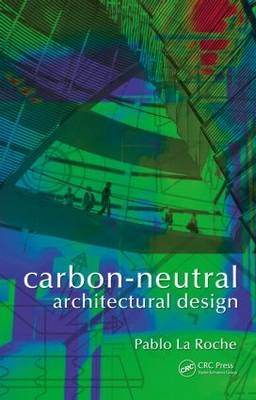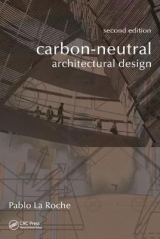
Carbon-Neutral Architectural Design
Crc Press Inc (Verlag)
978-1-4398-4512-7 (ISBN)
- Titel erscheint in neuer Auflage
- Artikel merken
Filling an urgent need for a design reference in this emerging field, Carbon-Neutral Architectural Design describes how to reduce building-related greenhouse gas emissions through appropriate design techniques. This full-color book presents strategies and methods to achieve CO2 reductions, with an emphasis on control of energy flows through the building envelope and passive heating and cooling strategies.
Strategies for Designing Buildings with a Smaller Carbon Footprint
Examining climate change and its relationship with buildings, the book begins with a look at the sources of emissions and how these are produced as a result of interactions between buildings and the surrounding environment. It then introduces a carbon-neutral architectural design process (CNDP) and a roadmap that can be adjusted for different types of projects.
Discussing climate analysis and solar geometry, the book explores how understanding the climate where a building is located helps to identify the design strategies that are best suited to that location—whether warm and humid, warm and dry, temperate, or cold. It looks at psychrometrics and how to achieve thermal comfort with minimum emissions. The book also explains how building fabric can be used to control energy flows by conduction, radiation, and convection—helping to reduce overheating and overcooling—and how to incorporate passive cooling and heating systems through appropriate design.
The book includes useful references, equations, and illustrations, as well as a comparison of free carbon counting tools that can be used for residential building design. Drawing on the author’s extensive experience in teaching and practice, this is a valuable resource for anyone who wants to reduce the carbon footprint of buildings.
Find more study resources at the American Institute of Architects’ Carbon Neutral Design Project web site.
What’s next for green building? See what Dr. La Roche has to say in this video on the HMC Architects blog.
Pablo La Roche is Professor in the Department of Architecture and Adjunct Professor at the Lyle Center for Regenerative Studies at California State Polytechnic University Pomona, where he has coordinated and taught design studios, environmental control systems, advanced electives, and seminars. In 2008 he led an interdisciplinary team of faculty and students that won the National Council of Architectural Registration Boards (NCARB) Grand Prize for the Department of Architecture. He has a Bachelors in Architecture and a Masters of Science in Architecture from Universidad del Zulia, Venezuela, and a PhD in Architecture from the University of California, Los Angeles. Dr La Roche has extensive international experience in designing passive cooling systems, low-energy sustainable architecture, and affordable housing, and has published more than 120 papers on these topics in conferences and journals in the Americas, Europe, Asia, and Australia. He has also been a technical reviewer for many international scientific conferences in the Americas, Europe, and India. Dr. La Roche is the principal author of Keeping Cool: Guidelines to Avoid Overheating in Buildings (2001), the sixth book in a series published by the Passive Low Energy Architecture Association (PLEA). Dr. La Roche is also the Director of Sustainable Design at HMC Architects, where he leads this California-based architecture firm’s ArchLab group, dedicated to advancing high-performance low-carbon architecture. He is a registered architect in Venezuela and a LEED BD+C accredited professional in the USA. His projects, emphasizing sustainability and affordability, have been published or received awards in Latin America and Europe. For more information about Dr. La Roche, see Dr. La Roche’s web site at Cal Poly Pomona, Zero Carbon Design, and HMC Architects.
Buildings and Greenhouse Gas Emissions
The Greenhouse Effect
Anthropogenic Emissions and Climate Change
Effects of Anthropogenic Emissions on Climate Change
Greenhouse Gas Emissions and Buildings
Carbon-Counting Tools
Comparison of Carbon-Counting Tools
References
Carbon-Neutral Architectural Design
Architectural Design Process
Carbon-Neutral Architectural Design Process
Implementation of the Carbon-Neutral Design Process in Academia
Integration
Carbon-Neutral Architectural Design Process in Practice
References
Thermal Comfort
Psychrometrics
Thermal Comfort
Environmental and Comfort Indices
Comfort Models
The Perception of Comfort
References
Climate and Architecture
Climate
Climate and Architecture
Climate Zones
Climate Zones and Energy Codes
Climate Analysis
Vernacular Architecture
Effects of Climate on Emissions
References
Solar Geometry
The Sun in the Sky Vault
Solar Charts
Shading the Building
Design of the Shading System
Sundials
Site Analysis
Calculating the Impact of Radiation on Surfaces
Orientation of Buildings
Low Energy Envelope Design
Heat Transfer through the Building Envelope
Design to Control Conduction
Design to Control Radiation
Design to Control Convection
Passive Cooling Systems
Definition of a Passive Cooling System
Classification of Passive Cooling Systems
The Ambient Air as a Heat Sink (Sensible Component)
Ambient Air as a Heat Sink (Latent Component: Evaporative Cooling)
The Upper Atmosphere as a Heat Sink: Radiant Cooling
The Earth as a Heat Sink: Earth Coupling
Applicability of Passive Cooling Systems
References
Passive Heating
Applicability of Passive Heating
Control of Heat Loss
Passive Solar Heating
Types of Passive Heating Systems
Effects of Design Strategies on Emissions
References
Index
| Erscheint lt. Verlag | 31.1.2012 |
|---|---|
| Zusatzinfo | 45; 162 Line drawings, color; 326 Halftones, black and white; 25 Tables, black and white; 490 Illustrations, black and white |
| Verlagsort | Bosa Roca |
| Sprache | englisch |
| Maße | 156 x 235 mm |
| Gewicht | 726 g |
| Themenwelt | Naturwissenschaften ► Biologie ► Ökologie / Naturschutz |
| Technik ► Architektur | |
| Technik ► Bauwesen | |
| Technik ► Bergbau | |
| Technik ► Elektrotechnik / Energietechnik | |
| Technik ► Umwelttechnik / Biotechnologie | |
| ISBN-10 | 1-4398-4512-3 / 1439845123 |
| ISBN-13 | 978-1-4398-4512-7 / 9781439845127 |
| Zustand | Neuware |
| Haben Sie eine Frage zum Produkt? |
aus dem Bereich



